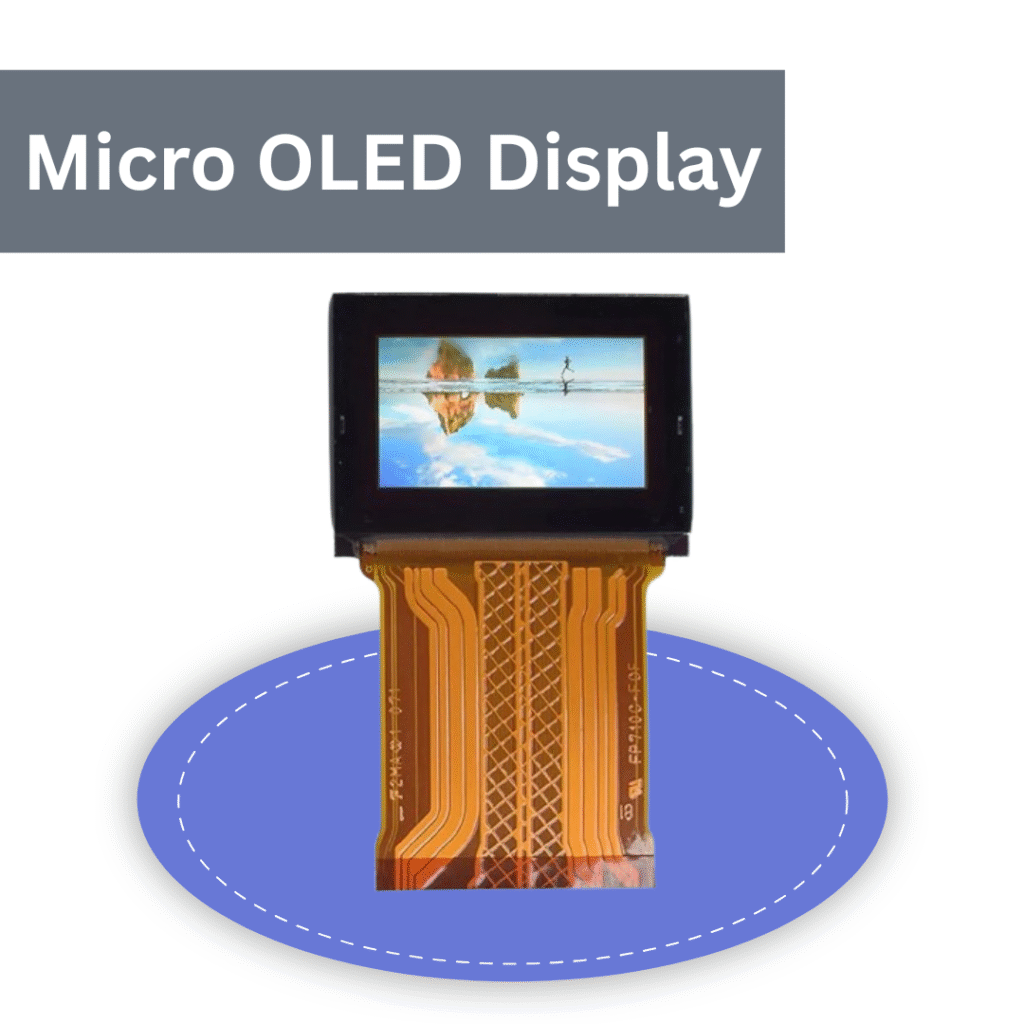When you hear terms like OLED and Micro OLED Display, it’s easy to assume they are nearly the same. However, they serve different purposes, perform differently, and are designed for different types of devices. OLED (Organic Light Emitting Diode) has been around for years, commonly found in televisions, smartphones, and tablets. The Micro OLED Display, also known as OLED-on-silicon, is newer and built for more advanced and compact devices like AR/VR headsets and wearables.
Micro OLED Display vs OLED: What Makes It Superior?
In this guide, we will explain how Micro OLED Display compares to OLED in terms of pixel density, size, power efficiency, brightness, contrast, and other critical factors to help you understand why Micro OLED is considered superior in specific applications.
What Is an OLED Display?

OLED stands for Organic Light Emitting Diode. In this type of display, each pixel lights up individually when electric current passes through organic materials. Since each pixel can emit its own light, OLED displays don’t need a backlight. This makes them thinner, more flexible, and able to produce deeper blacks compared to LCD screens. When a pixel turns off, it goes completely black, creating a strong contrast.
OLED displays are widely used in everyday consumer devices like televisions, smartphones, tablets, and laptops. They provide excellent color reproduction, good viewing angles, and smooth image transitions. OLED is also known for its energy efficiency compared to older display technologies like LCD. However, it has some limitations, such as the risk of screen burn-in if static images are displayed for too long and a gradual reduction in brightness over time.
OLED display benefits:
- Self-lit pixels for high contrast and deep blacks
- No need for backlight, allowing thinner screens
- Rich color output and wide viewing angles
- Widely available in various screen sizes
- Moderate power usage depending on brightness levels
What Is a Micro OLED Display?

Micro OLED, also called OLED-on-silicon, is a newer form of OLED technology. Instead of being built on glass or plastic substrates like traditional OLEDs, Micro OLED panels are manufactured directly on a silicon wafer. This allows for much smaller pixel sizes and extremely high pixel densities—often over 2000 pixels per inch.
Micro OLED is not flexible, but it excels in performance where compact, high-resolution screens are needed. These displays are commonly used in advanced devices such as AR/VR headsets, military optics, camera viewfinders, and smart glasses. Because of the silicon base, the display can be integrated with electronic circuits directly, leading to better performance in terms of refresh rate and response time.
Micro OLED display benefits:
- Very high resolution in a small screen size
- Faster image response and lower display latency
- Lower power usage due to efficient pixel control
- Suitable for close-up viewing and head-mounted devices
- Better pixel control due to silicon integration
Key Differences Between Micro OLED and OLED
While both technologies use self-emissive organic materials, Micro OLED and OLED are built differently and serve different purposes. Below is a detailed comparison:
| Feature | OLED | Micro OLED |
|---|---|---|
| Substrate | Glass or plastic | Silicon |
| Pixel Density | 300–400 PPI | 2000–3000+ PPI |
| Flexibility | Yes | No |
| Common Size Range | 5–80 inches | <1 inch |
| Brightness | Moderate to High | High (in small areas) |
| Contrast Ratio | Excellent | Excellent |
| Power Consumption | Moderate | Low |
| Refresh Rate | Fast | Faster |
| Cost | Lower | Higher |
| Ideal Use Cases | TVs, smartphones, laptops | AR/VR headsets, optics, wearables |
Main takeaways:
- OLED is ideal for large, flexible, and cost-efficient screens.
- Micro OLED is best for small, sharp, and responsive displays where space is limited.
Applications Where Micro OLED Wins
Micro OLED shines in areas where compact design, sharp visuals, and power efficiency are critical. Its ability to deliver extremely high resolution in a very small screen makes it a top choice for close-up displays.
Where Micro OLED performs best:
- AR/VR headsets – Delivers immersive visuals with sharp detail and minimal latency.
- Smart glasses – Compact and efficient displays for wearable tech.
- Camera viewfinders – Provides high clarity and color accuracy in small modules.
- Medical tools – Helps in displaying real-time images for diagnostic or surgical use.
- Military scopes – Enhances vision in tactical equipment using high contrast and brightness.
These applications depend on Micro OLED’s strengths like fast refresh, compact size, and precise pixel rendering. This makes Micro OLED more suitable than traditional OLED for these use cases.
Where OLED Still Makes Sense
Even though Micro OLED is more advanced in some areas, standard OLED technology remains the preferred option for many consumer and commercial applications. Its flexibility, lower cost, and availability in various sizes make it a practical choice.
Best applications for OLED:
- Televisions – Ideal for large screens with rich color and deep contrast.
- Smartphones and tablets – Balances cost and performance in mobile devices.
- Monitors and laptops – Supports smooth visuals and color accuracy for work or gaming.
- Smartwatches and fitness bands – Flexible OLED panels adapt well to wearable form factors.
In these scenarios, OLED continues to deliver great image quality, power savings, and usability for general consumer electronics.
The Future of Micro OLED
The market for Micro OLED displays is growing rapidly, driven by demand in AR, VR, and professional optics. As more companies invest in production, costs are expected to drop, making Micro OLED accessible to broader industries.
Key trends shaping Micro OLED’s future:
- Increased production scale – Ongoing investment to reduce cost per unit.
- Improved brightness and color – Advances in organic materials for better visual performance.
- Broader adoption in consumer tech – From premium AR devices to high-end wearables.
- Material improvements – Reducing burn-in and extending lifespan for long-term use.
As technology improves, Micro OLED is expected to become a mainstream solution in industries that need compact, high-resolution, and fast displays.
In the End
Micro OLED and traditional OLED displays each have a clear place in today’s technology world. OLED remains the top choice for larger, flexible displays like TVs, smartphones, tablets, and monitors due to its excellent image quality, affordability, and mature manufacturing processes. It delivers rich contrast, vibrant colors, and a thinner design that fits most mainstream electronics.
However, when it comes to compact, high-performance applications—such as AR/VR headsets, smart glasses, digital viewfinders, and advanced optics—Micro OLED leads the way. Its unmatched pixel density, lower power consumption, and ultra-fast response times make it ideal for up-close and immersive viewing experiences where traditional OLED falls short.
The choice between OLED and Micro OLED depends entirely on your specific needs. If your priority is a large, affordable screen with great visuals, OLED is the right fit. But if you’re working with small devices that require precision, clarity, and efficiency, Micro OLED is clearly the superior option.
As both technologies evolve, we’ll likely see them continue to complement each other—each filling a unique role in next-generation displays.
Frequently Asked Questions (FAQs)
Q1: What is the difference between OLED and Micro OLED?
A: OLED is used for larger displays and built on glass or plastic. Micro OLED is built on silicon and used in smaller, high-performance screens.
Q2: Which has better pixel density, OLED or Micro OLED?
A: Micro OLED has much higher pixel density, making it ideal for close-up viewing in devices like AR/VR headsets.
Q3: Is Micro OLED more expensive than OLED?
A: Yes, currently Micro OLED is more expensive due to complex manufacturing and lower production volume.
Q4: Can Micro OLED replace OLED in all devices?
A: No, Micro OLED is best suited for compact devices. OLED is more practical for large screens like TVs and smartphones.
Q5: Does Micro OLED have the same risk of burn-in as OLED?
A: Yes, both can suffer from burn-in, though Micro OLED often uses techniques to reduce this risk in high-usage devices.

